If you’re looking to boost your data skills in 2025, I recommend exploring some top business analytics books. Titles like the HBR Guide to Data Analytics for Managers and Data Analytics Essentials offer practical, easy-to-understand guidance perfect for beginners and managers. For deeper insights, books like Data Science for Business and Business Analytics, Global Edition, provide more strategic perspectives. Keep exploring these resources, and you’ll gain a strong foundation for making smarter, data-driven decisions.
Key Takeaways
- Focus on beginner-friendly titles like *HBR Guide to Data Analytics* and *Data Analytics Essentials* for foundational skills.
- Include strategic guides such as *Data & Analytics Strategy Book* to develop organizational data maturity.
- Consider practical, application-oriented books like *Business Analysis for Dummies* for real-world insights.
- Explore specialized resources on pricing analytics and data visualization for advanced skill-building.
- Prioritize books with practical tools, real-world examples, and clear guidance aligned with 2025 business analytics trends.
HBR Guide to Data Analytics Basics for Managers (HBR Guide Series)
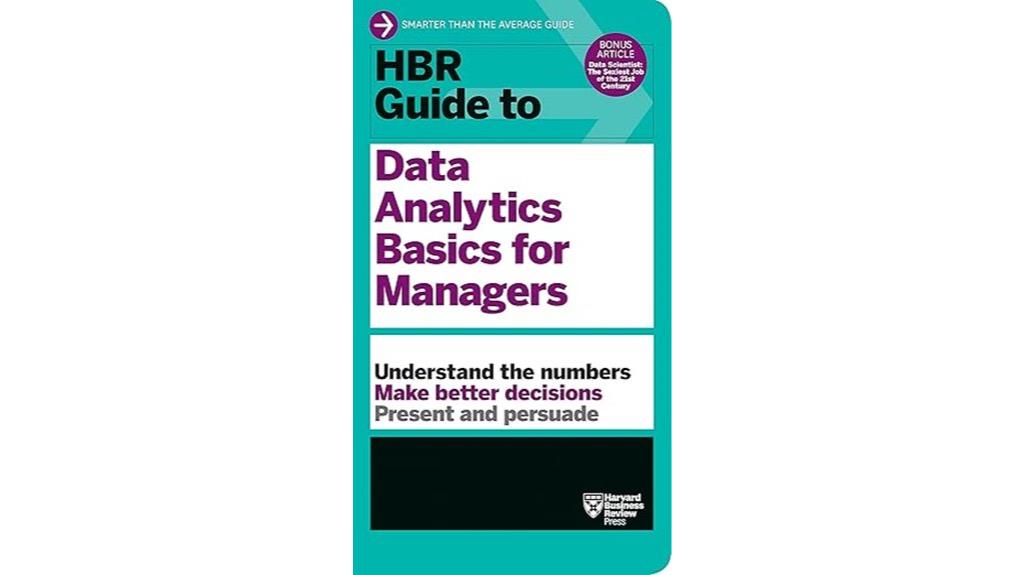
If you’re a manager or business professional looking to grasp the essentials of data analytics without getting bogged down in technical details, the HBR Guide to Data Analytics Basics for Managers is an ideal starting point. Authored by renowned expert Thomas Davenport, this approachable book simplifies complex concepts, focusing on practical understanding. It covers statistical tools, data interpretation, visualization, and predictive analysis, all in clear language with real-world examples. Designed for both novices and experienced professionals, it helps you communicate analytics results effectively and build confidence in data-driven decision-making. It’s a valuable primer that makes data analytics accessible and actionable for managers.
Best For: managers, business professionals, and graduate students seeking a clear, practical introduction to data analytics without technical complexity.
Pros:
- Simplifies complex data concepts with accessible language and real-world examples.
- Enhances communication skills between analysts and business leaders.
- Suitable for both novices and experienced professionals looking to build confidence in data-driven decision-making.
Cons:
- May lack in-depth technical detail for advanced analytics practitioners.
- Focused more on conceptual understanding than hands-on technical skills.
- Some users might find it too basic if seeking comprehensive statistical training.
Business Analytics: Data Analysis & Decision Making (MindTap Course List)
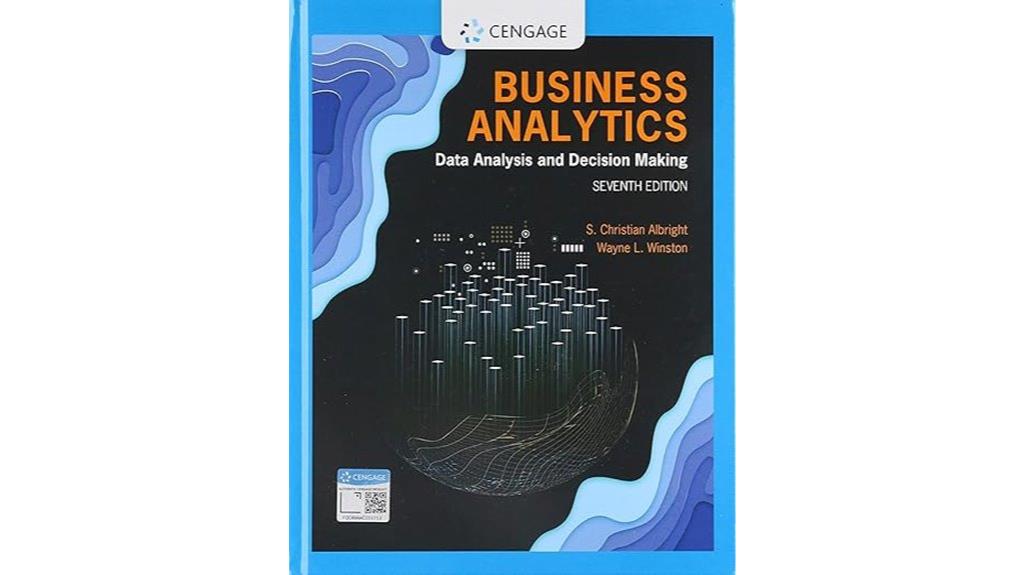
The “Business Analytics: Data Analysis & Decision Making” course list is best suited for data analysts seeking practical insights into Excel functions and key terminology. I found it somewhat limited, mainly focused on basic concepts with dry, hypothetical questions that don’t boost engagement. The writing is poorly organized, making instructions hard to follow, and there are errors like incorrect terminology and mismatched pages. The MindTap platform adds frustration with confusing answer formats and invalid access codes, and support is unhelpful. Overall, I wouldn’t recommend it for self-learners, as the technical issues outweigh the minimal benefits. It’s better used in structured courses with institutional support.
Best For: data analysts seeking practical Excel insights and terminology in a structured course setting with institutional support.
Pros:
- Engaging writing style encourages interaction through problem questions
- Provides useful summaries of key terms and Excel functions
- Suitable for courses with managed technical support and access
Cons:
- Poorly organized instructions make steps difficult to follow
- Technical issues on the MindTap platform cause frustration and confusion
- Inaccurate terminology, mismatched page numbers, and invalid access codes hinder effective learning
Data Analytics Essentials Book

Data Analytics Essentials You Always Wanted To Know by Dr. Bianca Szasz offers a straightforward, practical introduction to data analytics for beginners. I found it perfect for grasping fundamental concepts, tools, and techniques without feeling overwhelmed. The book’s structure, with summaries, review questions, and real-world examples, makes self-study effective and engaging. It covers everything from data types and collection methods to visualization and predictive modeling. Designed for those new to the field, it builds confidence and provides a solid foundation. While not deeply technical, it’s an excellent starting point, especially for career changers or students enthusiastic to understand how data analytics applies across industries.
Best For: Beginners, students, and professionals seeking a clear, practical introduction to data analytics without extensive technical detail.
Pros:
- Accessible and easy-to-understand language suitable for beginners.
- Includes summaries, review questions, and real-world examples to reinforce learning.
- Covers a broad range of fundamental topics, providing a solid foundation in data analytics.
Cons:
- Lacks in-depth technical or advanced analytical methodologies.
- Some concepts, especially related to AI tools, may be outdated or require supplementing.
- Not ideal for those seeking specialized or highly technical knowledge in data analytics.
Business Analysis for Dummies (2nd Edition)
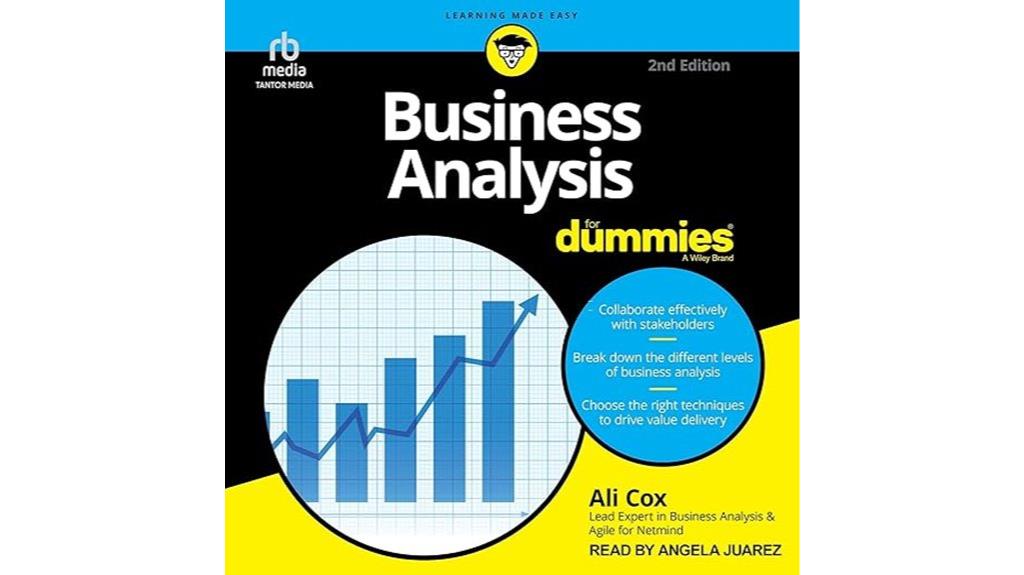
Business Analysis for Dummies (2nd Edition) stands out as an excellent starting point for newcomers to the field or professionals who want a clear, accessible overview of business analysis concepts. Although I’m not a formal BA, I’ve performed BA tasks for over a decade, and I find this book helpful. It explains roles, tools, and mindsets through relatable anecdotes, making complex ideas easier to grasp. While it lacks visual diagrams and isn’t ideal for certification prep, it provides a solid foundational understanding. If you’re new to business analysis or seeking a broad overview, this book is an eye-opener and a practical intro to the profession.
Best For: newcomers to business analysis or professionals seeking a clear, accessible overview of BA concepts without requiring certification-focused content.
Pros:
- Provides a straightforward and easy-to-understand introduction to business analysis roles, tools, and mindsets.
- Uses relatable anecdotes that help clarify complex concepts and make learning engaging.
- Suitable for beginners or practitioners seeking foundational knowledge without technical jargon.
Cons:
- Lacks visual diagrams, which could aid in understanding more complex processes.
- Not tailored for certification exam preparation or advanced technical knowledge.
- May not cover in-depth methodologies or detailed technical tools required for professional certification.
Data Science for Business Book
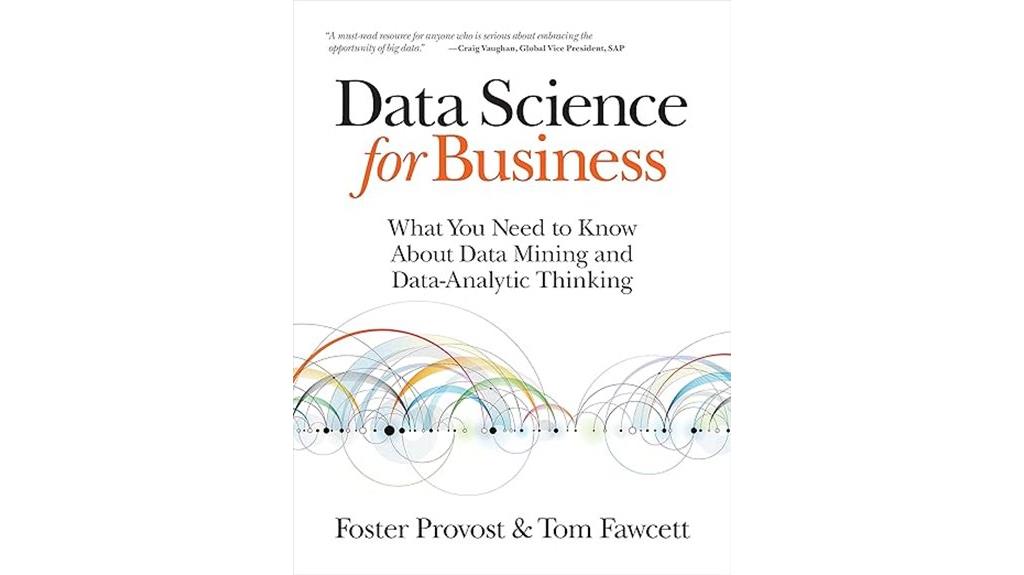
If you’re looking for a foundational guide that bridges the gap between theory and practical application in data science, “Data Science for Business” by Foster Provost and Tom Fawcett is an ideal choice. This book emphasizes data mining, data-analytic thinking, and principles for extracting insights from data. It covers essential concepts like predictive modeling, classification, clustering, and model evaluation, focusing on real-world business applications. The authors stress balancing intuition with analysis and highlight profit-based metrics over accuracy alone. While not technical in coding, it provides a solid framework for understanding how data science drives decision-making, making it a must-have for both beginners and seasoned professionals.
Best For: beginners and experienced professionals seeking a practical, non-technical introduction to data science concepts and business applications.
Pros:
- Provides a clear, foundational understanding of data mining and data-analytic thinking suitable for a broad audience.
- Focuses on real-world business applications with an emphasis on profit-based model evaluation.
- Balances theoretical principles with pragmatic insights, making it accessible and useful for decision-making.
Cons:
- Lacks detailed guidance on coding, implementation, and technical tools such as R, Python, or big data frameworks.
- Contains some inaccuracies, such as training and testing on the same dataset, which can mislead model evaluation practices.
- Does not extensively cover advanced topics like experimental design, reproducible research, or modern big data technologies.
Data and Analytics Strategy for Business
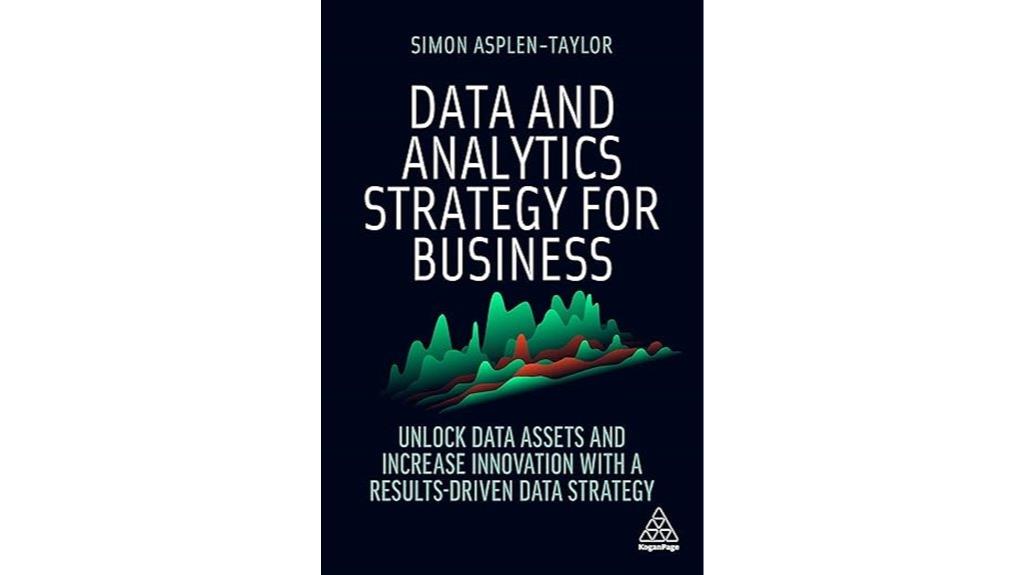
This book stands out as an ideal resource for professionals seeking a clear, practical guide to developing effective data and analytics strategies, even if they have little prior experience. It emphasizes that data’s true value comes from applying it to solve specific business problems, starting small with impactful projects. The book offers a structured roadmap to boost data capability, governance, and organizational maturity. It’s packed with practical tools, sector-specific examples, and visual resources that help map current positions and plan future steps. Overall, it’s a straightforward guide that empowers organizations to craft results-driven data strategies, revealing innovation and competitive advantage.
Best For: professionals and organizations seeking a clear, practical, and accessible guide to develop effective data and analytics strategies, regardless of prior experience.
Pros:
- Highly accessible writing suitable for beginners and experienced practitioners alike
- Provides practical tools, sector-specific examples, and visual resources for strategic planning
- Emphasizes a results-driven, step-by-step approach to maximizing data value and organizational growth
Cons:
- May require supplementary technical resources for advanced data implementation
- Focuses primarily on strategic development, with less emphasis on detailed technical execution
- Some sectors or organizations with highly complex needs might find the guidance too general or high-level
Essentials of Pricing Analytics (Mastering Business Analytics)
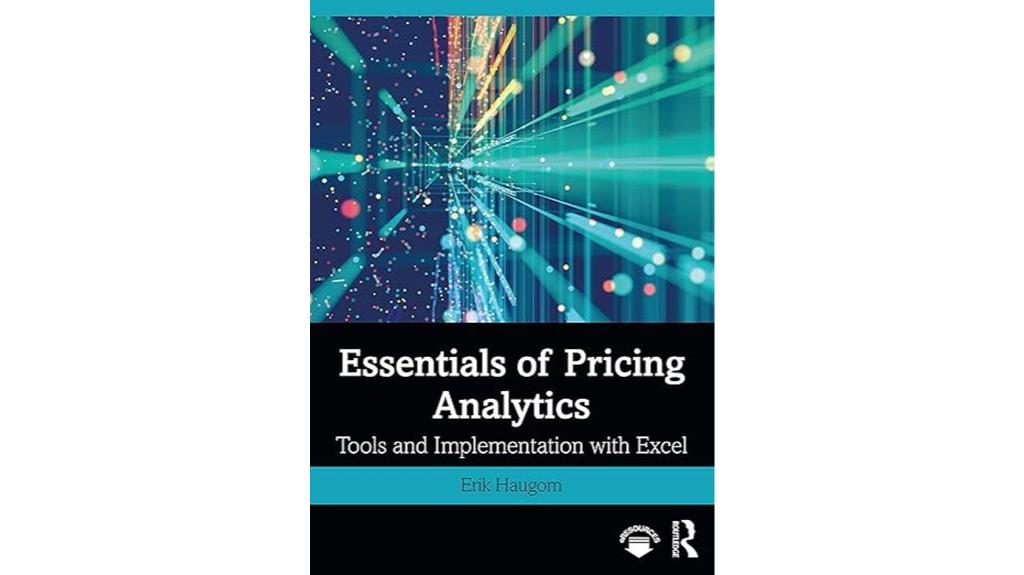
Essentials of Pricing Analytics (Mastering Business Analytics) stands out as an ideal resource for educators and professionals working within academic settings. It offers clear, relevant insights into modern pricing strategies, making complex concepts accessible. The book provides detailed guidance on pricing analytics techniques, though it lacks online supplementary materials. Instructor resources are exclusively available to accredited institutions, emphasizing its academic focus. This book is perfect for instructors and professionals seeking a broad, authoritative guide to current pricing practices. Keep in mind, it’s designed for formal educational use and isn’t suited for individual learners or self-study outside of academic environments.
Best For: educators and professionals in academic settings seeking an authoritative guide on modern pricing analytics techniques.
Pros:
- Provides clear, relevant insights into current pricing strategies.
- Offers detailed guidance on pricing analytics techniques.
- Well-regarded for clarity and content quality tailored to academic use.
Cons:
- Does not include online supplementary materials.
- Instructor resources are restricted to accredited institutions only.
- Not suitable for individual learners or self-study outside of formal educational environments.
Data Analytics & Visualization All-in-One For Dummies

Data Analytics & Visualization All-in-One For Dummies stands out as an ideal resource for beginners enthusiastic to grasp the fundamentals of data analytics and visualization tools. I find it valuable because it simplifies complex topics, making them accessible and easy to understand. The book covers essential concepts and modern tools like Power BI and Tableau, blending theory with practical examples. While it’s great for foundational learning, some sections have inaccuracies or oversimplifications, so I recommend supplementing it with other resources. Overall, it’s a solid starting point for anyone new to data analytics, helping them build confidence and initial skills efficiently.
Best For: Beginners eager to learn the fundamentals of data analytics and visualization tools in an accessible and straightforward manner.
Pros:
- Simplifies complex topics, making them easy to understand for newcomers
- Covers essential concepts and modern tools like Power BI and Tableau
- Combines theory with practical examples to enhance learning
Cons:
- Contains some inaccuracies and oversimplifications, especially for experienced readers
- Certain design recommendations, like database structures, may be outdated or suboptimal
- May require additional resources for advanced or critical topics to ensure accuracy
Storytelling with Data: Data Visualization Guide for Business Professionals
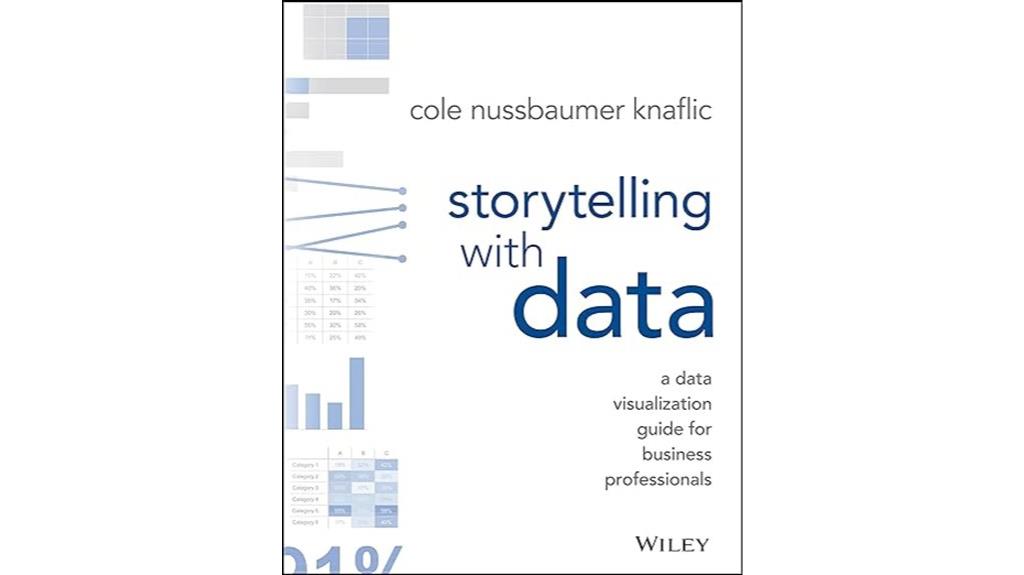
If you’re a business professional looking to improve how you communicate insights through visuals, “Storytelling with Data: Data Visualization Guide for Business Professionals” offers invaluable guidance. It provides a clear framework emphasizing intentionality and storytelling, helping you craft visuals that focus on what truly matters. The book advocates for simplicity, minimalism, and audience engagement, showing how to reduce clutter and highlight key messages. Filled with practical tips and real-world examples, it helps you design impactful graphics for presentations and reports. Perfect for those wanting to enhance their storytelling skills, it bridges the gap between data analysis and compelling communication.
Best For: business professionals, including managers, analysts, and consultants, seeking to enhance their data storytelling and visualization skills for clearer, more impactful communication.
Pros:
- Offers a clear, practical framework emphasizing storytelling and intentional design principles.
- Provides numerous real-world examples and visuals to illustrate effective data visualization techniques.
- Accessible for both beginners and experienced professionals, focusing on core concepts rather than technical complexity.
Cons:
- Lacks in-depth technical guidance on advanced dashboard or report design trade-offs.
- Primarily focuses on business storytelling, with limited coverage of technical data analysis or automation aspects.
- Some readers may find the emphasis on simplicity reduces visual engagement or variety in complex scenarios.
Business Analytics, Global Edition
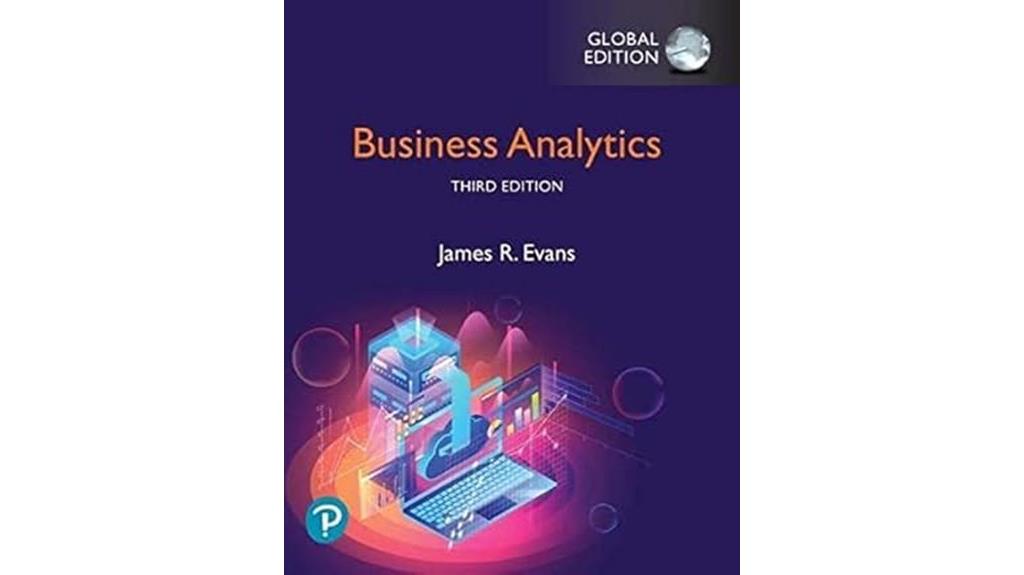
The “12 Best Business Analytics Books” is an excellent resource for students and professionals seeking an all-encompassing yet practical introduction to the field. Business Analytics, Global Edition, offers thorough coverage with exercises, tutorials, and examples using Excel and StatCrunch. It’s suitable for undergraduate and graduate courses, though some find the explanations lack depth. The book heavily emphasizes Excel, with limited integration of other tools, and its visualization techniques are basic. Despite organizational flaws and some outdated content, it remains popular for its broad scope and practical focus. Overall, it’s a solid foundational text, but supplementing with additional resources can enhance your understanding.
Best For: students and professionals seeking a comprehensive, practice-oriented introduction to Business Analytics with a focus on Excel and basic visualization techniques.
Pros:
- Thorough coverage of fundamental Business Analytics concepts with practical exercises and tutorials.
- Suitable for both undergraduate and graduate courses, offering broad educational value.
- Includes multiple formats (hardcover, loose-leaf, PDF), making it accessible for different learning preferences.
Cons:
- Relies heavily on Excel with limited integration of other technological tools, reducing exposure to diverse software.
- Visualizations are basic and can be poorly executed due to default settings, lacking sophistication.
- Organizational flaws in supplementary materials like the glossary and some outdated content can hinder efficient learning.
Analytics: A Business Leaders Guide to Using Data Effectively
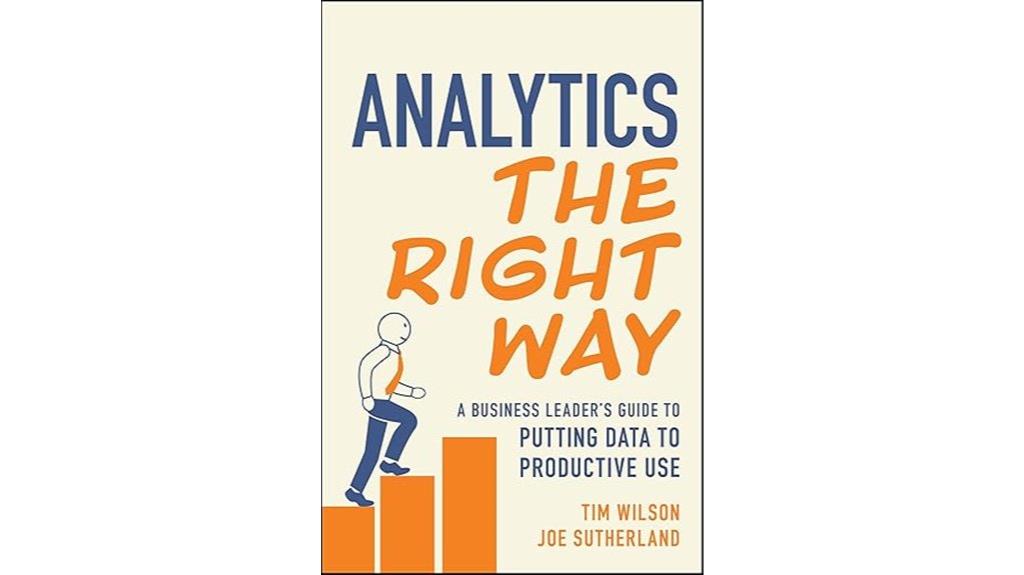
For business leaders seeking to harness analytics without getting bogged down in technical jargon, “Analytics: A Business Leaders Guide to Using Data Effectively” offers practical strategies that focus on turning insights into action. This book emphasizes understanding KPIs, predicting project outcomes, and making informed decisions, rather than just technical setup. It highlights the importance of hypotheses, validation, and continuous testing, encouraging leaders to doubt assumptions and test repeatedly. With accessible frameworks, real-world examples, and engaging graphics, it bridges the gap between data analysis and strategic decision-making, empowering leaders to liberate data’s full potential for business growth.
Best For: business leaders, managers, and analysts seeking practical, non-technical guidance to leverage data for strategic decision-making and business growth.
Pros:
- Provides accessible frameworks and real-world examples to bridge the gap between data analysis and strategic action
- Emphasizes practical, hypothesis-driven testing and validation to improve decision quality
- Engages readers with witty remarks, graphics, and clear insights, making complex topics approachable
Cons:
- May lack in-depth technical details for analysts seeking advanced data science techniques
- Focuses primarily on strategic application, possibly overlooking detailed data engineering processes
- Some readers might find the emphasis on testing and hypotheses challenging to integrate into fast-paced decision cycles
Business Analytics: Data Analysis & Decision Making – Standalone book
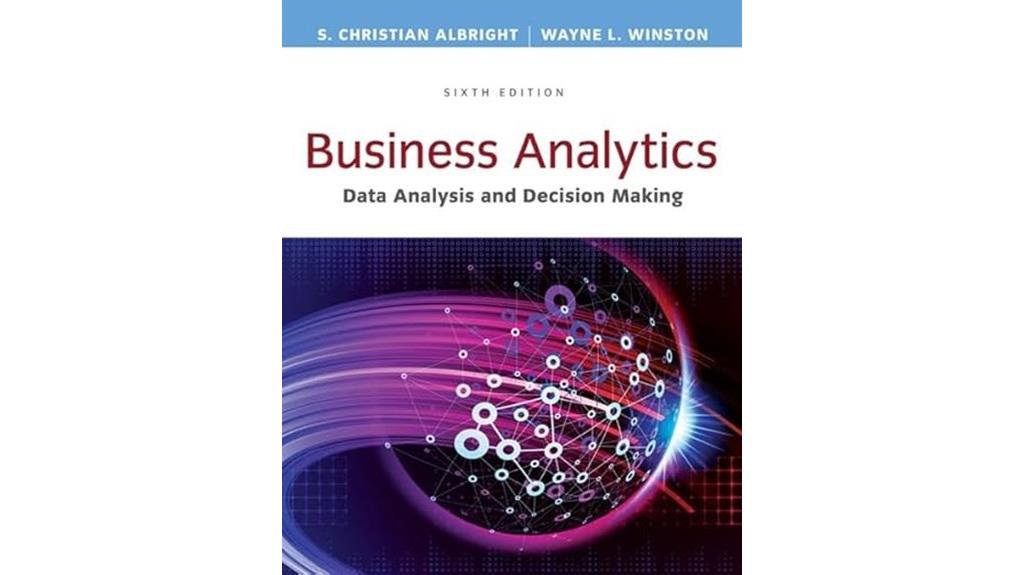
Business Analytics: Data Analysis & Decision Making stands out as a practical resource for beginners who want to grasp data analytics without a heavy math background. I found it helpful for its clear explanations, examples, and guidance tailored for those new to the field. However, some users, including myself, notice that the content can be challenging, especially without prior math experience. The book relies heavily on third-party Excel add-ins like StatTools, which aren’t Mac-compatible, limiting usability for many. While it offers useful insights, the focus on tools over core Excel skills might frustrate learners seeking a more extensive overview. Overall, it’s a good starting point but has notable limitations.
Best For: beginners seeking an accessible introduction to data analytics with minimal math background, despite some usability limitations.
Pros:
- Clear explanations and practical examples help reinforce understanding.
- Suitable for those new to data analytics and decision making.
- Offers guidance tailored for learners with little prior knowledge in the field.
Cons:
- Heavy reliance on third-party Excel add-ins like StatTools, which are not compatible with Mac.
- Limited coverage of core Excel skills, focusing more on external tools.
- Content can be challenging for non-mathematics majors, with insufficient alternative methods explained.
Factors to Consider When Choosing Business Analytics Books

When selecting a business analytics book, I look at who it’s meant for to make certain it matches my skill level and goals. I also consider how deep the content goes, whether it includes practical examples, and if the visuals help clarify complex ideas. Additionally, I check the author’s expertise to trust that I’m learning from a credible source.
Audience Relevance
Choosing the right business analytics book hinges on understanding your current skill level and professional role. If you’re a beginner, look for titles that introduce core concepts clearly without overwhelming technical jargon. For intermediate or advanced readers, select books that dive deeper into analysis techniques or industry-specific applications. Consider whether the book is tailored for business professionals, analysts, or data scientists—this ensures the content matches your responsibilities and expertise. Check if it addresses your industry or particular interests, like marketing or finance, to increase practical relevance. Also, review the language and style to see if it aligns with your learning preferences, whether you prefer conceptual overviews or technical detail. Lastly, see if the book offers exercises or resources that help you meet your educational or career goals.
Technical Depth
Selecting a business analytics book requires careful consideration of its technical depth to match your current knowledge and learning goals. I recommend checking if the book offers the right balance between theory and practice, so you’re not overwhelmed or under-challenged. Consider whether it covers essential technical topics like statistical methods, data modeling, or algorithms relevant to your needs. If you’re aiming to deepen your skills, see if it includes advanced tools or programming languages like Python, R, or machine learning. Align the content’s complexity with your goals—whether you’re building a solid foundation, gaining hands-on analysis skills, or seeking deep technical expertise. Ensuring the technical depth matches your proficiency will make your learning more effective and enjoyable.
Practical Examples
Practical examples are essential in business analytics books because they demonstrate how theoretical concepts translate into real-world applications. I look for books that include well-illustrated case studies and scenarios, as they help me see the relevance of techniques across different industries and functions. Examples featuring data visualization and decision-making processes show how insights are derived and communicated effectively. I also value books that incorporate real data and case-based exercises, as they bridge the gap between academic ideas and everyday business challenges. These practical examples allow me to practice analytical thinking and problem-solving step-by-step, making complex concepts more accessible. Ultimately, they deepen my understanding and boost my confidence in applying analytics skills to real-world situations.
Visual Content Quality
Have you ever struggled to grasp complex analytics concepts because the visuals were cluttered or misleading? High-quality business analytics books fix this by featuring clear, well-designed visualizations that communicate data insights effectively. Consistent color schemes, straightforward labels, and simplified graphics make information easier to read and understand, reducing mental effort. It’s essential that visuals accurately represent data without distortion or exaggeration, preserving credibility and trust. Well-crafted images and diagrams can clarify abstract ideas and boost memory retention of key principles. Additionally, visuals showcasing real-world examples help translate theory into practical application. When choosing a book, prioritize those with clean, precise visuals that enhance comprehension, making complex analytics concepts accessible and engaging. Good visuals truly make a difference in mastering data skills.
Author Expertise
When choosing a business analytics book, one of the most important factors is the author’s expertise. An author with proven industry experience or strong academic credentials can offer practical, credible insights that truly enhance your understanding. Recognized experts or thought leaders in data science are more likely to present current methodologies and best practices, keeping you up-to-date. Books from authors affiliated with reputable institutions or published by trusted series, like Harvard Business Review, tend to be more reliable and well-researched. Experienced authors often include real-world case studies and examples, making concepts easier to grasp and apply. Ultimately, books by authoritative voices help ensure foundational concepts are covered thoroughly and accurately, reducing the risk of misinformation and boosting your confidence in applying new skills.
Book Accessibility
Choosing a business analytics book isn’t just about the content; how you access and interact with its materials matters just as much. I always check if the book provides clear information about access codes, digital resources, and online platforms needed for study. It’s important to verify whether supplementary materials like datasets, quizzes, or instructor resources are easily accessible and compatible with my devices. I also consider whether the format—hardcover, PDF, or e-book—fits my preferred learning style and if digital versions work smoothly with my reading devices. Additionally, I look out for any access restrictions or sharing limitations for digital content, especially for self-study or institutional use. Ensuring these factors are met makes my learning experience smoother and more effective.
Supplementary Resources
What supplementary resources a business analytics book offers can considerably impact how well I grasp and apply the concepts. I look for books that include online tutorials, case studies, and practice exercises, as these tools deepen my understanding and help me apply what I learn. Digital platforms with interactive tools, datasets, and quizzes are invaluable for reinforcing skills. Access to online communities, forums, or webinars provides additional support, clarifications, and real-world insights beyond the pages. Resources like software guides, coding tutorials, and visualization templates help bridge the gap between theory and practice, enabling me to develop practical technical skills. Combining these resources with case-based learning, industry reports, and actual project examples allows me to build a richer, more contextual understanding of business analytics.
Cost and Format
Considering the wide range of supplementary resources that can enhance my understanding of business analytics, the cost and format of the books I select play a significant role in my decision-making process. I need to verify the price fits my budget, especially if I plan to buy multiple titles or access online materials. Evaluating formats like hardcover, paperback, Kindle, or PDFs helps me choose the most convenient and accessible option. Digital formats can sometimes have compatibility issues with certain devices, so I check for smooth usability. I also look for used or rental copies to save money without sacrificing content quality. Additionally, I consider any extra costs, such as access codes or online resources, which could increase the overall expense.
Frequently Asked Questions
Which Book Is Best for Beginners in Business Analytics?
You’re asking about the best book for beginners in business analytics, and I recommend starting with “Data Analytics Made Accessible” by Dr. Anil Maheshwari. I found it incredibly clear and approachable, perfect if you’re new to the field. It covers fundamental concepts without overwhelming you, making complex topics easy to understand. I believe it’s a great way to build a solid foundation before diving deeper into more advanced analytics.
How Do These Books Address Data Visualization Techniques?
You’re curious about how these books tackle data visualization techniques. I find that they often start with fundamental principles, like choosing the right chart types and emphasizing clarity. They then introduce tools and software, like Tableau or Power BI, to bring data to life. These books also highlight storytelling with visuals, helping me communicate insights effectively and make data-driven decisions with confidence.
Are These Books Suitable for Non-Technical Business Professionals?
Imagine sitting in a cozy café, sipping coffee, and feeling overwhelmed by complex data jargon. These books are perfect even if you’re not a tech whiz. They break down concepts into simple, relatable terms, making analytics accessible. I’ve found they empower business professionals like you to confidently interpret data, make smarter decisions, and turn numbers into stories—no coding required. They’re truly a bridge to data-driven success for everyone.
Do Any of These Books Cover Advanced Predictive Analytics?
You’re curious if any of these books cover advanced predictive analytics. I can tell you that some titles do delve into complex techniques like machine learning and deep predictive models, which are essential for advanced analytics. I recommend checking the book descriptions to see if they include topics like neural networks or ensemble methods. These resources are perfect if you’re ready to go beyond basics and explore sophisticated predictive strategies.
Which Book Offers Practical Case Studies for Real-World Application?
You’re curious about which book provides practical case studies for real-world application. I recommend “Data Science for Business” by Foster Provost and Tom Fawcett. I found it incredibly useful because it offers clear, real-world examples that help you understand how to apply analytics techniques directly to business problems. The case studies make complex concepts tangible, so you can confidently implement what you learn in your own work.
Conclusion
If you’re serious about sharpening your data skills, these books are your treasure map. Each one offers a unique piece of the puzzle, helping you navigate the complex world of business analytics with confidence. Think of them as your trusted compass—guiding you through the data jungle. Immerse yourself, stay curious, and watch your insights grow sharper than a hawk’s eye. Your data-driven success story starts here!











